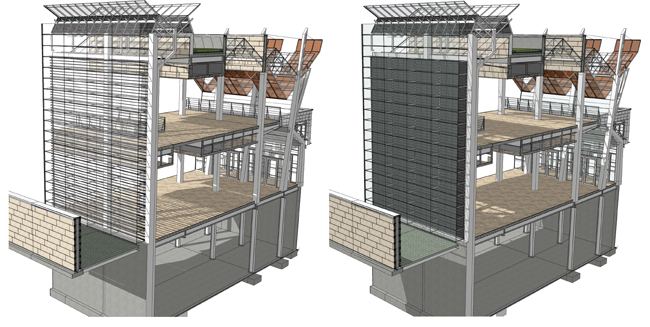Fall 2007 Arch. 451: Architecture Design V (UG) Carbon Neutral Studio
Building Integrated Photovoltaics

Design Performance Objective |
Building Integrated Photovoltaics
In this student design of a ventilating south facade, the BIPV is installed on the between the two layers of glazing, within the ventilation cavity. Because this wall is not used for fresh air ventilation to the interior, the PV artificially warms the air in the cavity, aiding in its evacuation. The PV is installed on an operable louver, with open and closed positions to allow for solar gain when the louvers are in the horizontal orientation, or to block solar gain when the louvers are in the vertical orientation. The system would have to be carefully managed to maximize the efficiency of this system, but it is an aggressive approach to BIPV.
|
Student: Joshua McGarvey
|
Software/Tools: |
none |
|
Fall 2007 Arch. 451: Architecture Design V (UG) Carbon Neutral Studio
Building Integrated Photovoltaics
Combine photovoltaics as an on-site renewable energy strategy with the built form of the studio project.
|
Investigative Strategy |
BIPV is one strategy that marries the energy production potential with the building envelope. Students estimate an approximate energy load, and compare those estimates with predicted supply from renewable sources including BIPV. In the Chicago climate, the rule of thumb is 10 square feet of roof mounted PV generates approximately 1kW of electricity during peak production hours. Because this translates into 1 square foot PV supplies energy for 1 square foot of the gross building footprint, BIPV and building massing are an important relationship to manage at the conceptual level. |
Evaluation Process |
To the degree that one can account for the supply and demand of energy on a given studio project, the BIPV should become part of the on-site renewable supply. Assessment of BIPV might consist of the scope of research and investigation undertaken by the student, or it might be related to the accuracy of measuring the output potential, orientation decision-making, and/or building material relationships and joinery. Another accounting method may be for the student to do an annual accounting for electricity generated versus energy consumed. Depending upon hours of daytime and night time operation and other variables, zero net energy may become a possible option. |
Evaluative Criteria |
An important criteria is the seamless integration of the output technology with the building envelope as 1) a system, and 2) its aesthetic approach/value. Since students are really working at the conceptual level, a degree of speculation is acceptable. But the success of BIPV has to do with the system accomplishing multiple aims beyond simply producing energy. |
Information about the Project and Studio |
• course outline
• project outline |
Cautions/Possible Confusions |
If net metering is not available, PV is less valuable as an approach. Daytime and nighttime usage is very important in overall energy accounting, and cannot be overlooked when planning for BIPV.
|
Range of Applicability in terms of CLIMATE |
|
Range of Applicability in terms of TYPE |
|
Reference Material |
|
Duration of Exercise |
Part of a semester long design studio. I only teach semester long design studios (or two semester long projects). I never teach short “sketch” projects, because they reinforce the idea that you can just breeze in and out of design without any long term responsibility. If a project is a “sketch” problem, it is always tied to a larger relevance in a future project. |
Degree of Difficulty / Previous Knowledge Required |
While this could be offered in a lower level studio (imagine BIPV as a “system” only, a “transparent/translucent co-planar system” that happens to be PV instead of glazing or kalwall), it is most likely an upperlevel assignment. |
| |
|
|
| |
|

